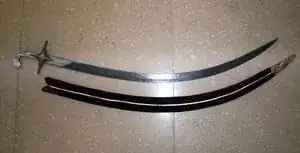I was reminded of this by our recent discussion of the old chestnut about possible shapes for utility hole covers. Perhaps this question is less familiar.
A sword can be made in any shape at all, but if you want to be able to put it into a scabbard, only certain shapes will do. For simplicity, let us neglect the width of the sword, and take it to be the image of a continuous mapping $[0,1]\to {\Bbb R}^3$. Clearly, a sword in the shape of a circular arc will fit into a similar scabbard, as long as the arc is less than about half of a full circle:

(For non-mathematical reasons, such swords are rarely more than about $\frac1{36}$ of circle.)
If we let the curvature go to zero, we get the special case of a straight segment, which can be of any length:

It seems to me that if one had a sword which was a helical segment, it would go into a matching scabbard. The circular and straight swords are special cases of this, where the helical pitch is zero. (A cursory search for helical swords or scabbards turned up nothing—unsurprisingly, since a sword which has to be worked into the enemy like a corkscrew is a really stupid idea.)
Are there any other shapes of swords which will go into scabbards?